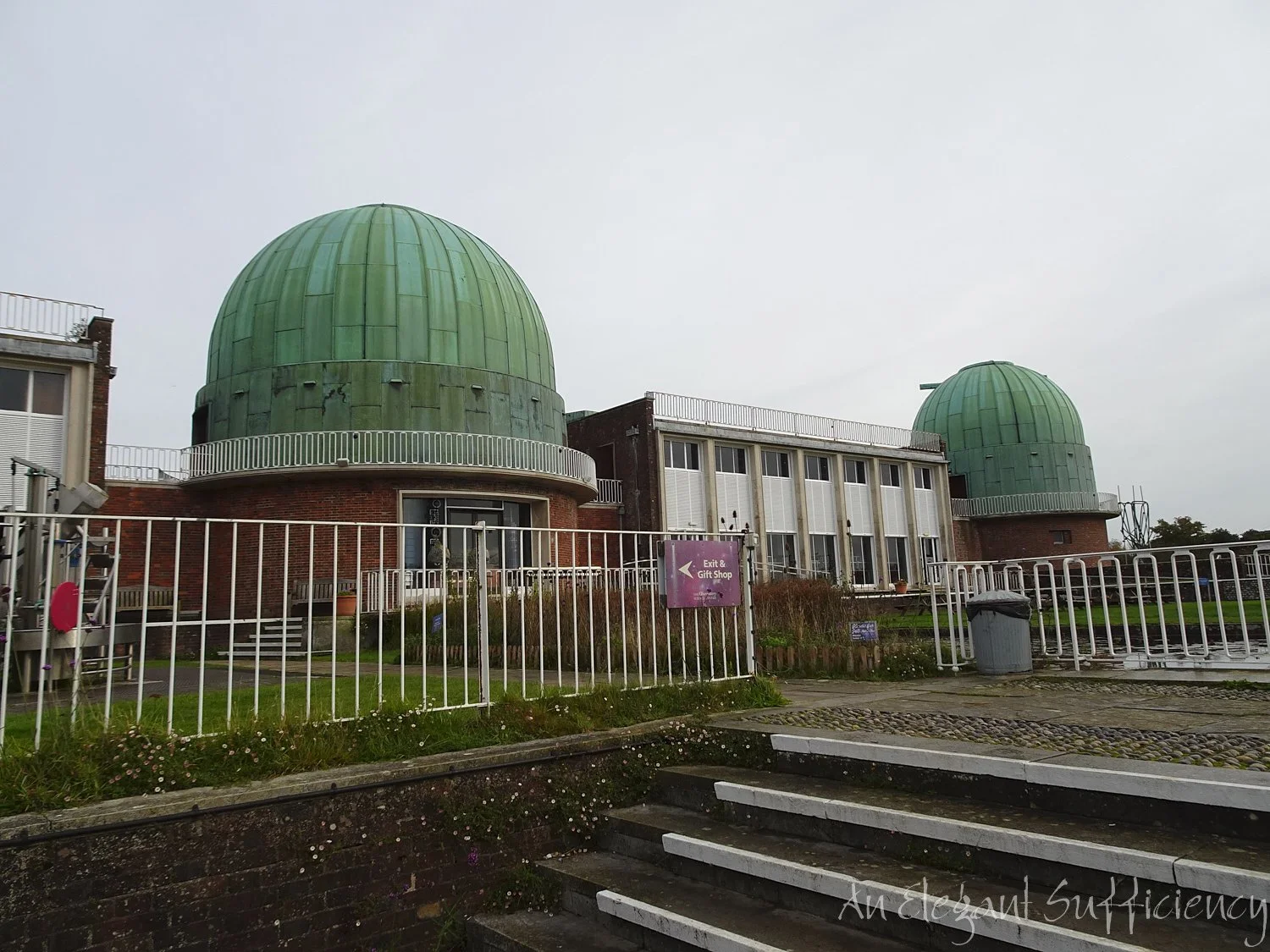Carol saves the day
We were driving home on Monday but had thought that we might take advantage of being in this corner of the country and visit somewhere of interest whilst we were here. We’d tried to sort out a visit to Charleston sometime over the weekend but just couldn’t get our plans and their opening times to tally. But I remembered seeing somewhere intriguing whilst watching our favourite Landscape Artist of the Year TV series and had an idea it was near here. A search on Google immediately produced the details of the castle and a little more diligence confirmed that yes, the Observatory was here too. My Hero booked us in for Monday morning and here we were.
It wasn’t the most pleasant weather for a visit like this, but never mind, we were in good spirits and curious about this place. We didn’t have long - we still had a long journey ahead of us. We parked the car on the grass as instructed (a little strange, we thought) and made our way towards the entrance.
One of us might have commented on the general shabbiness of the place at this point. Bearing in mind this was a site of national importance, not to mention a visitor attraction in a relatively affluent area of the country, we were surprised at the poor signage and lack of information.
Such things might be regarded as unimportant and I know we have had an especially wet few weeks recently, but surely, someone around here might have a lawn mower?
Or maybe it’s part of a rewilding project?
We made our way in, showed our booking details at the desk and explained that we didn’t have much time. What were the must-sees? “Everything” was the answer. Oh, and there was a scheduled presentation at 11am, the start of which would be announced over the loudspeaker.
Off we went.
The first exhibit was right there, just beyond the entrance/gift shop. A huge disc of Pyrex glass.
The importance of this Pyrex disc was clearly explained on the board beneath it and reading the more detailed article about it once home shed a little light on the background to the project. It also offered a hint to the wider organisation and politics (with a small p) involved in the development and day to day running of the observatory.
We’d already observed the characteristics of the site here, which reminded us of the “modern” schools and public buildings from our childhood in the 1950s and 60s. Many of the structures have listed building status which restricts what can be done and perhaps explains the overall impression we’d had so far.
We followed the pathway past a kind of playground with water-based activities for children. We were not sure what we’d been expecting here at the Observatory, but this came as a bit of a surprise.
So far, we were feeling pretty underwhelmed.
Once inside the exhibition, we hoped to learn a little more about the place. We both have science backgrounds and are generally excited by such things, needing no persuasion to be wowed by some of the extraordinary facts and features of the world we live in.
But really? We expected more than a series of amusements, however many scientific principles they were intended to illustrate.
Maybe we should go inside one of the domes and take a closer look. Perhaps there’s a telescope in there with some more interesting details and a better explanation?
Well, yes, here was a huge telescope and an orrery set alongside it, showing the movement of the planets. Such things are always interesting and we spent a few minutes identifying each of them and watching their orbits around the sun.
But so far, practical information about the telescope and how it was used was somewhat lacking. I wanted to know how one actually looks through such a huge thing? What might be seen? Is it still used? So many questions and so far, no answers.
But just around the corner, my Hero found a panel with the story of the telescope. It seemed to be in keeping with our mood so far! We looked at one another and wondered how much longer we really wanted to hang around this place. Had we had enough?
Stepping back outside and noting what appeared to be the remains of a planetary display of some sort alongside what looked like another playground, we realised there was just one dome left on the way out and back to the car park. Maybe we should take a look in the telescope in there on the way out?
It’s actually the first observatory dome we saw when we arrived; the one by the pathway to the entrance and houses the Thompson 26” refracting telescope. In we went and wandered around it. I was still asking the same questions, curious to know more about it, but it was dark, empty and there was no information to be seen. My Hero noticed the step ladder and we wondered if one needed to climb that to operate the thing, but then we spotted some information on the wall and learned that this was really a huge camera…maybe it wasn’t possible to “look through” it?
Feeling rather short-changed, we had another quick look round, decided there was nothing more to see (and maybe we’d google it all later) and went back outside.
And that was where we met Carol.
It must have been 11am, for we heard an announcement about the presentation which was about to begin. Having greeted us with a cheery Good Morning, she asked if we were headed to watch the show. With a slightly shamefaced look on our faces, we explained that we had a long journey and that we’d probably better be going.
“Or I could give you a quick run through of the presentation about this telescope I’m going to give at 12. I was coming here to check everything was on and working anyway. Oh good grief, let’s begin by switching the lights on shall we?”
And with one switch, our mood and overall impression of the place took a turn for the better. We’d been looking around in the dark - who knew there were supposed to be lights in here? No wonder we couldn’t see any information! In the next fifteen minutes or so, Carol conveyed her enthusiasm and in her explanation about this telescope answered so many of those questions I’d been gathering during our visit. How would we look through the telescope then? Unsurprisingly, we hadn’t noticed the tracks on the wooden panelled walls which revealed that the floor rises around the central telescope to enable the viewer to access it! It wasn’t just the facts and figures that made all the difference, it was the little details that don’t appear on information boards and websites, but which a great guide shares as a throwaway remark. For example…
"That huge counterweight means that you can move the whole telescope with a touch of your little finger”
So thank you Carol! We were so fortunate to encounter you before we left.
I think the task here is more than one woman, however enthusiastic, could tackle, sadly. I’m not altogether sure what needs to be done here without a serious amount of money being spent. If the history of the Observatory is anything to go by, the agreement of a large number of people and the organisations they represent would be required to make the smallest of changes. For now, though, perhaps someone with a lawn mower and a paintbrush might make all the difference - not to the domes, which have weathered naturally, but to the small bits and pieces like the fences and window frames which might at least make the place appear more cared for.
It was time for us to head off home though. As we left, we passed by the queue of people waiting to enter the Observatory and caught an insight to the main audience here: families and young children, for whom the amusements and water games would be far more important than peeling paint and long grass.





























